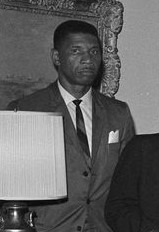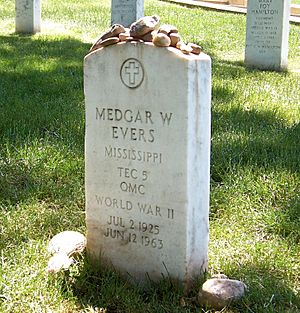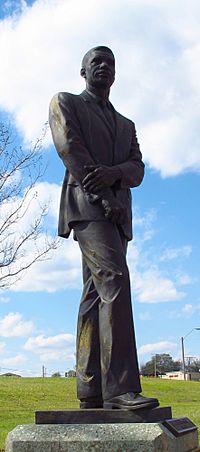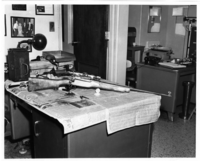Medgar Evers facts for kids
Quick facts for kids
Medgar Evers
|
|
|---|---|

Evers at the White House in 1961
|
|
| Born |
Medgar Wiley Evers
July 2, 1925 Decatur, Mississippi, U.S.
|
| Died | June 12, 1963 (aged 37) Jackson, Mississippi, U.S.
|
| Cause of death | Gunshot wounds |
| Burial place | Arlington National Cemetery (with full military honors) |
| Education | Alcorn State University (BA) |
| Occupation | Civil rights activist |
| Spouse(s) | |
| Children | 4, Dylan J Robinson, Darrell K Evers, James V Evers, Reena D Evers |
| Relatives | Charles Evers (brother) |
| Military career | |
| Allegiance | United States |
| Service/ |
United States Army |
| Years of service | 1943–1945 |
| Rank | Sergeant |
| Battles/wars | |
Medgar Wiley Evers (/ˈmɛdɡər/; July 2, 1925 – June 12, 1963) was an American civil rights activist and the NAACP's first field secretary in Mississippi. Evers, a decorated U.S. Army combat veteran who had served in World War II, was engaged in efforts to overturn segregation at the University of Mississippi, end the segregation of public facilities, and expand opportunities for African Americans including the enforcement of voting rights.
A college graduate, Evers became active in the Civil Rights Movement in the 1950s. Following the 1954 ruling of the United States Supreme Court in Brown v. Board of Education that segregated public schools were unconstitutional, Evers challenged the segregation of the state-supported public University of Mississippi, applying to law school there. He also worked for voting rights, economic opportunity, access to public facilities, and other changes in the segregated society. Evers was awarded the 1963 NAACP Spingarn Medal.
Contents
Early life
Evers was born on July 2, 1925, in Decatur, Mississippi, the third of five children (including elder brother Charles Evers) of Jesse (Wright) and James Evers. The family included Jesse's two children from a previous marriage. The Evers family owned a small farm and James also worked at a sawmill. Evers and his siblings walked 12 miles (19 kilometers) a day to attend segregated schools; eventually Medgar earned his high school diploma.
Evers served in the United States Army during World War II from 1943 to 1945. He was sent to the European Theater where he participated in the Normandy landings in June 1944. After the end of the war, Evers was honorably discharged as a sergeant.
In 1948, Evers enrolled at Alcorn Agricultural and Mechanical College (a historically black college, now Alcorn State University), majoring in business administration. He also competed on the debate, football, and track teams, sang in the choir, and was junior class president. He earned his Bachelor of Arts in 1952.
On December 24, 1951, he married classmate Myrlie Beasley. Together they had three children: Darrell Kenyatta, Reena Denise, and James Van Dyke Evers.
Activism
The couple moved to Mound Bayou, Mississippi, a town developed by African Americans, where Evers became a salesman for T. R. M. Howard's Magnolia Mutual Life Insurance Company. Evers was also president of the Regional Council of Negro Leadership (RCNL), which began to organize actions for civil rights; Evers helped organize the RCNL's boycott of gasoline stations that denied blacks the use of the stations' restrooms. Evers and his brother Charles attended the RCNL's annual conferences in Mound Bayou between 1952 and 1954, which drew crowds of 10,000 or more.
In 1954, following the U.S. Supreme Court decision that segregated public schools were unconstitutional, Evers applied to the state-supported University of Mississippi Law School, but his application was rejected because of his race. He submitted his application as part of a test case by the NAACP.
On November 24, 1954, Evers was named as the NAACP's first field secretary for Mississippi. In this position, he helped organize boycotts and set up new local chapters of the NAACP. He was involved with James Meredith's efforts to enroll in the University of Mississippi in the early 1960s.
Evers also encouraged Dr. Gilbert Mason Sr. in his organizing of the Biloxi wade-ins from 1959 to 1963, protests against segregation of the city's public beaches on the Mississippi Gulf Coast. Evers conducted actions to help integrate Jackson's privately owned buses and tried to integrate the public parks. He led voter registration drives, and used boycotts to integrate Leake County schools and the Mississippi State Fair.
Evers's civil rights leadership, along with his investigative work, made him a target of white supremacists. Following the Brown v. Board of Education decision, local whites founded the White Citizens' Council in Mississippi, and numerous local chapters were started, to resist the integration of schools and facilities. In the weeks before his assassination, Evers encountered new levels of hostility. His public investigations into the 1955 lynching of Chicago teenager Emmett Till in Mississippi, and his vocal support of Clyde Kennard, had made him a prominent black leader. On May 28, 1963, a Molotov cocktail was thrown into the carport of his home. On June 7, 1963, Evers was nearly run down by a car after he came out of the NAACP office in Jackson, Mississippi.
Assassination

Evers was assassinated in 1963 at his home in Jackson, Mississippi, now the Medgar and Myrlie Evers Home National Monument, by Byron De La Beckwith, a member of the White Citizens' Council in Jackson. This group was formed in 1954 in Mississippi to resist the integration of schools and civil rights activism.
Evers was taken to the local hospital in Jackson, where he was initially refused entry because of his race. His family explained who he was and he was admitted; he died in the hospital 50 minutes later. He was 37 years old. Evers was the first black man to be admitted to an all-white hospital in Mississippi.
Mourned nationally, Evers was buried on June 19 in Arlington National Cemetery, where he received full military honors before a crowd of more than 3,000.
Evers's assassination and the resulting trials inspired civil rights protests. An estimated 5,000 people marched from the Masonic Temple on Lynch Street to the Collins Funeral Home on North Farish Street in Jackson. Allen Johnson, Reverend Martin Luther King Jr. and other civil rights leaders led the procession. Although all-white juries failed to reach verdicts in Beckwith's first two trials in the 1960s, he was convicted in 1994 based on new evidence.
Medgar's widow, Myrlie Evers, became a noted activist in her own right, serving as national chair of the NAACP. In 1969 his brother Charles became the first African American to be elected mayor of a Mississippi city in the post-Reconstruction era.
Evers's life and death inspired numerous works of art, music, and film.
Legacy

Evers was memorialized by leading Mississippi and national authors both black and white: James Baldwin, Margaret Walker, Eudora Welty, and Anne Moody. In 1963, Evers was posthumously awarded the Spingarn Medal by the NAACP. In 1969, Medgar Evers College was established in Brooklyn, New York, as part of the City University of New York.
Evers's widow Myrlie Evers co-wrote the 1967 book For Us, the Living with William Peters. In 1983, a television movie was made based on the book. Celebrating Evers's life and career, it starred Howard Rollins Jr. and Irene Cara as Medgar and Myrlie Evers, airing on PBS. The film won the Writers Guild of America award for Best Adapted Drama.
In 1969, a community pool in the Central District neighborhood of Seattle, Washington, was named after Evers, honoring his life.
On June 28, 1992, the city of Jackson, Mississippi, erected a statue in honor of Evers. All of Delta Drive (part of U.S. Highway 49) in Jackson was renamed in Evers's honor. In December 2004, the Jackson City Council changed the name of the city's airport to Jackson–Medgar Wiley Evers International Airport in his honor.

His widow Myrlie Evers became a noted activist in her own right, eventually serving as national chairperson of the NAACP. Myrlie also founded the Medgar Evers Institute in 1998, with the initial goal of preserving and advancing the legacy of Medgar Evers's life's work. Anticipating the commemoration of the 50th anniversary of the assassination of Medgar Evers and recognizing the international leadership role of Myrlie Evers, the Institute's board of directors changed the organization's name to the Medgar and Myrlie Evers Institute.
Medgar's brother Charles Evers returned to Jackson in July 1963, and served briefly with the NAACP in his slain brother's place. He remained involved in Mississippi civil rights activities for many years, and in 1969, was the first African-American mayor elected in the state. He died on July 22, 2020, aged 97.
On the 40th anniversary of Evers's assassination, hundreds of civil rights veterans, government officials, and students from across the country gathered around his grave site at Arlington National Cemetery to celebrate his life and legacy. Barry Bradford and three students—Sharmistha Dev, Jajah Wu, and Debra Siegel, formerly of Adlai E. Stevenson High School in Lincolnshire, Illinois—planned and hosted the commemoration in his honor. Evers was the subject of the students' research project.
In October 2009, Navy Secretary Ray Mabus, a former Mississippi governor, announced that USNS Medgar Evers (T-AKE-13), a Lewis and Clark-class dry cargo ship, would be named in the activist's honor. The ship was christened by Myrlie Evers-Williams on November 12, 2011.
In June 2013, a statue of Evers was erected at his alma mater, Alcorn State University, to commemorate the 50th anniversary of his death. Alumni and guests from around the world gathered to recognize his contributions to American society.
Evers was honored in a tribute at Arlington National Cemetery on the 50th anniversary of his death. Former President Bill Clinton, Attorney General Eric Holder, Navy Secretary Ray Mabus, Senator Roger Wicker, and NAACP President Benjamin Jealous all spoke commemorating Evers.
He was identified as a Freedom hero by The My Hero Project.
In 2017, the Medgar and Myrlie Evers House was named as a National Historic Landmark. In 2019, the site was designated a National Monument.
See also
 In Spanish: Medgar Evers para niños
In Spanish: Medgar Evers para niños


